DARWINISM FOR BEGINNERS: Picture books that introduce children to evolution • Jonathan Emmett

Until recently, the UK school curriculum did not require children to be taught about evolution until they reached secondary school. In September 2014, after years of lobbying by scientists and other groups, evolution was introduced into the final year (age 10-11) of the primary curriculum. While this is a step in the right direction, research has shown that children are more likely to accept evolution’s rational explanation of creation if they’re introduced to it towards the beginning of their primary education rather than at the end, by which time less-rational explanations (both religious and non-religious) may have taken root.
For the last few years I've been using my poem My Cousin is a Cucumber (from Skyboy and other Stupendous Science Stories ) to explain to Year 3 and 4 classes that all life on Earth is believed to have a single common ancestor. Most seven-year-olds are fascinated to learn that they are descended from an "itsy-bitsy blob of life" and amused to discover that they are the distant cousins of both cockatoos and cucumbers. An awareness of evolution is fundamental to a child’s proper understanding of the natural world and, if presented in an appropriate and engaging way, there is no good reason for evolution not to be introduced to children as young as five or six.
Picture books can be a very effective way to introduce evolution to children from an early age. How the Borks Became , my new picture book with Elys Dolan, was written specifically to explain natural selection, the process by which evolution takes place. It was developed in consultation with Boston University’s Child Cognition Lab who have been researching how to teach evolution effectively to young children. As a result of their research, the team developed their own natural selection picture book, How the Piloses Evolved Skinny Noses , which is aimed at a slightly older age group to How the Borks Became and explains the process in a more detailed way. You can find out more about the team’s research and their book at evolvingmindsproject.org.
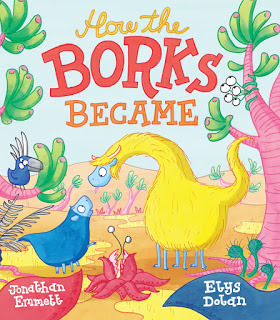
How the Borks Became follows the evolution of a fictional species, the llama-like Borks, who live on “a far distant planet, quite like our own Earth”. The books shows how three environmental factors - climate, predation and availability of food – result in Borks evolving from smooth-furred, short-necked, blue creatures into shaggy, long-necked, yellow ones.
 How the Borks Became shows how natural selection transforms the Borks from smooth-furred, short-necked, blue creatures into shaggy, long-necked, yellow ones.
How the Borks Became shows how natural selection transforms the Borks from smooth-furred, short-necked, blue creatures into shaggy, long-necked, yellow ones.The use of a fantasy species gives the book licence to represent the process of natural selection in a speeded-up, caricatured form over just four generations of Borks. A page at the end of the book explains that evolution on Earth happens at a far slower rate with much smaller changes and that it might take an Earth animal millions of years to change as much as the Borks in the story.
 When a greedy predator gobbles up all of the blue-furred borks, only the better-camouflaged yellow-furred Borks are left to parent the next generation.
When a greedy predator gobbles up all of the blue-furred borks, only the better-camouflaged yellow-furred Borks are left to parent the next generation.Here are five more picture books that do a great job of introducing the fundamentally important topic of evolution to children at primary school age.
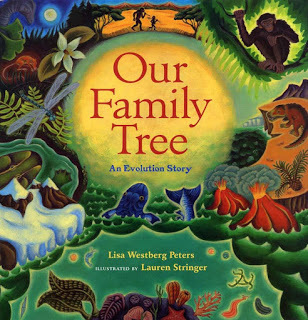 Our Family Tree: An Evolution Story
written by Lisa Westberg Petersillustrated by Lauren StringerSuitable for age 5 and above.
Our Family Tree: An Evolution Story
written by Lisa Westberg Petersillustrated by Lauren StringerSuitable for age 5 and above.This is a US picture book, but can easily be bought on import. Westberg Peter’s simple, poetic text charts the evolution of humans from our beginnings as simple mono-cellular organisms to the present day, highlighting significant stages along the way. Stringer’s illustrations intercut pictures of creatures in their natural habitats with images of a family mapping out an evolutionary diagram on a sandy beach. These sand drawings are cleverly employed to illustrate important developments in internal anatomy, such as the appearance of backbones and lungs. A glossary page and timeline at the back of the book give additional details and a sense of perspective to the book’s four billion year narrative.
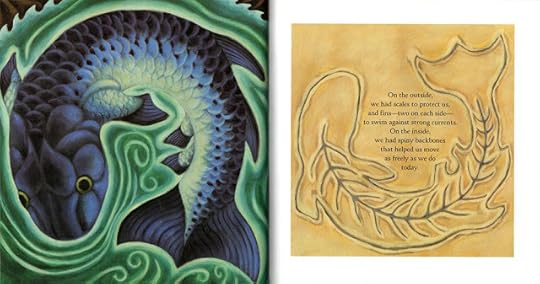 A spread from Our Family Tree, showing the development of fins and a backbone.
A spread from Our Family Tree, showing the development of fins and a backbone.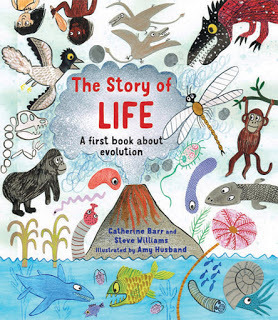 The Story of Life
written by Catherine Barr and Steve Williamsillustrated by Amy HusbandSuitable for age 6 and above.
The Story of Life
written by Catherine Barr and Steve Williamsillustrated by Amy HusbandSuitable for age 6 and above.This book covers an even longer timeline than Our Family Tree and charts the evolution of all life on Earth with the time period displayed in the corner of each page. Amy Husband’s lively illustrations display the diversity of Earth’s plant and animal life at various stages in its early history, before narrowing the focus to show the last 12 million years of human evolution from the the first apes to modern man on the last four spreads. The book finishes with an environmental message about the need to look after the planet that is our only home.
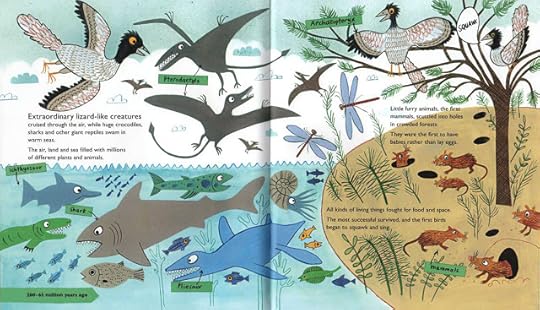 This spread from The Story of Life illustrates the diversity of life on prehistoric Earth.
This spread from The Story of Life illustrates the diversity of life on prehistoric Earth.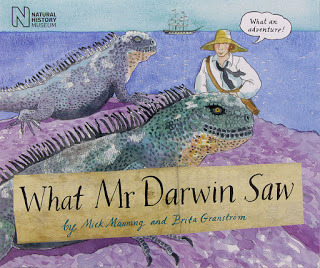 What Mr Darwin Sawby Mick Manningand Brita GranströmSuitable for age 7 and above.
What Mr Darwin Sawby Mick Manningand Brita GranströmSuitable for age 7 and above.Although the concept of evolution predated Charles Darwin, it was not widely accepted until Darwin discovered the principle of natural selection. Mick Manning and Brita Granström’s biographical picture book spans the life of this revolutionary scientist, but focusses chiefly on the five years the young Darwin spent as a captain’s companion and naturalist aboard the HMS Beagle. The book uses scenes from the voyage and excerpts from Darwin’s diary to show how his encounters with the plants and animals of South America, and the Galapagos Islands in particular, informed his subsequent work.
 What Mr Darwin Saw illustrates how Darwin’s experiences during the voyage of the HMS Beagle informed his later work.
What Mr Darwin Saw illustrates how Darwin’s experiences during the voyage of the HMS Beagle informed his later work. The Misadventures of Charles Darwinwritten by Isabel Thomasillustrated by Pete WilliamsonSuitable for age 9 and above.
The Misadventures of Charles Darwinwritten by Isabel Thomasillustrated by Pete WilliamsonSuitable for age 9 and above.This book, part of Oxford University Press’s Treetops in Fact series, presents an entertaining biography of Darwin’s life, from “stinky schoolboy” to aged “celebrity scientist”. It also does a great job of explaining Darwin’s theories clearly and succinctly and examines some of their implications for science and culture. Isabel Thomas’s engaging and accessible text is liberally peppered with archive photographs and Pete Williamson’s illustrations and ‘Mythbuster’ panels throughout the book help to correct common misconceptions about Darwin’s life and work.
 This spread from The Misadventures of Charles Darwin looks at how Darwin’s theories were initially received.
This spread from The Misadventures of Charles Darwin looks at how Darwin’s theories were initially received.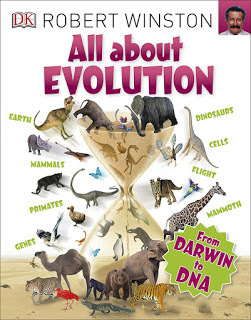 All About Evolution: From Darwin to DNAby Robert Winston(Previously published as Evolution Revolution)Suitable for age 10 and above.
All About Evolution: From Darwin to DNAby Robert Winston(Previously published as Evolution Revolution)Suitable for age 10 and above.This book, written by scientist and broadcaster Robert Winston is crammed with detailed information on every aspect on evolution, from its historical development as an idea, to its possible implications for the future of mankind. One minor criticism is that some spreads feel a little too crowded, making it difficult to take in the content, but this is easily forgiven given the breadth and quality of information the book contains. Although this book is probably more suited to secondary school readers, it contents will be of interest to more advanced and inquisitive readers in their final years of primary school as well.
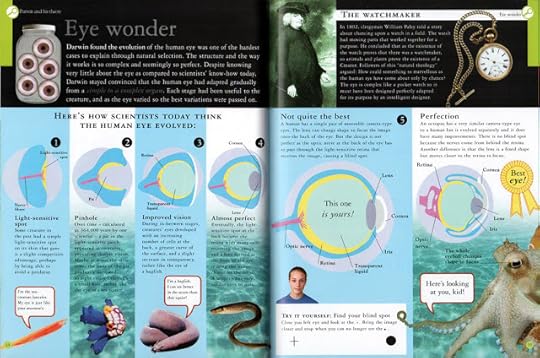 This spread from All About Evolution shows how scientists think complex structures like the human eye evolved via a series of incremental changes.
This spread from All About Evolution shows how scientists think complex structures like the human eye evolved via a series of incremental changes.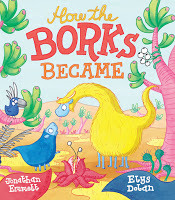 How the Borks Became An Adventure in Evolution by Jonathan Emmett and Elys Dolan is published by Otter-Barry Books. Find out more about the book and download some activity sheets here.
How the Borks Became An Adventure in Evolution by Jonathan Emmett and Elys Dolan is published by Otter-Barry Books. Find out more about the book and download some activity sheets here.Find out more about Jonathan and his books at his Scribble Street web site or his blog. You can also follow Jonathan on Facebook and Twitter @scribblestreet.
See all of Jonathan's posts for Picture Book Den.
Published on May 06, 2018 22:30
No comments have been added yet.



